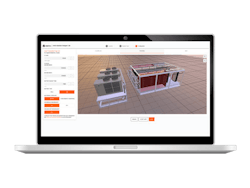Vertiv's Free Online Configurator Eases Prefabricated Modular Data Center Design, Planning
This month, Vertiv has brought forth a new tool which aims to transform and simplify the configuration of prefabricated modular (PFM) data centers.
Available currently for customer deployments in the company's Europe, Middle East and Africa (EMEA) business, Vertiv Modular Designer Lite is a web-based application intended to streamline the process of designing PFM data centers based on the Vertiv SmartMod and Vertiv SmartMod Max platforms.
Geared to meet specific user needs, the new online tool is billed as an "easy and intuitive platform for designing an all-in-one data center."
Requiring no logins or software downloads, the company said the tool's intuitive qualities ensure accessibility for any level of technical expertise, allowing users to start designing data centers immediately.
The tool enables 2D and 3D visualizations of PFM data center configurations up to 200 kilowatts (kW). Planned configurations can be saved for future reference and quick modification.
The tool gives users access to essential technical documentation about their configured data center designs, including technical descriptions and product brochures. Users can communicate directly through the tool with Vertiv experts throughout any given design process.
As the process unfolds, Vertiv experts can help to enhance users' initial designs via the internal, more sophisticated version of the application (Vertiv Modular Designer), which offers additional capabilities to optimize PFM data center designs based on site conditions, expected performance, and/or desired levels of security.
“I have personally utilized this tool online during customer discussions, effectively exploring and presenting diverse design alternatives,” asserted Siniša Stojanoski, DCCS BU, X86 specialist, SEE from Dell Technologies. "Its intuitive interface and robust features provide a streamlined solution for designing modular data centers, enabling customers to visualize their configurations effectively and make informed decisions, reducing time and costs."
The company emphasized that data centers configured within the app are tailored to meet the specific needs and geographical location of each user.
By incorporating inputs such as site location, weather data for precise cooling equipment sizing, IT load requirements, rack specifications, battery backup considerations, and electrical topology preferences, Vertiv contends the free app allows for optimal levels of customization and redundancy planning in PFM data center designs.
Viktor Petik, Vice President of Vertiv's Integrated Modular Solutions business, concluded:
"Vertiv Modular Designer Lite empowers users to effortlessly design their own data centers, tailored precisely to their needs. With its intuitive interface and comprehensive features, this tool represents a significant step forward for early planning of modular data center design."
DX Cooling System
Three years ago we saw Green Revolution Cooling (GRC) launch an immersion cooling design for extreme-density computing supporting up to 200 kW of server capacity, which at that time counted as pushing data center density limits (oh, how times have changed).
No word on whether the expanded Vertiv configurator calculates for modular immersion cooling, but a quick trial by DCF showed that the free tool provides for PFM designs of 100 to 200 kW employing direct expansion (DX) cooling.
As explained recently on Vertiv's site, a direct expansion or DX cooling system is a type of air-conditioning system that removes heat from a space through evaporation and condensation of a refrigerant which absorbs heat in the air generated by IT equipment in a network closet or other IT space, and ultimately rejects the heat outdoors. The refrigerant as chemically constructed boils below room temperature, and is condensed back to a liquid by transferring the heat to outdoor air or water through a heat exchanger.
In a DX cooling system, an evaporator unit is placed inside the space to be cooled. The refrigerant enters the DX cooling coils, where it absorbs the heat from the air and transforms into a gas. The refrigerant then moves into the condenser unit located outside, where the heat is released. An expansion valve between the evaporator and the condenser helps facilitate the changes in the pressure and temperature of the refrigerant as it moves through this cooling process. A compressor drives the refrigerant throughout the entire DX cooling system, which is a closed loop solution.
As noted by Vertiv, compared to chilled water and other types of cooling systems commonly found in data centers or other IT spaces, DX cooling provides flexibility and can serve to cut costs if the number of heat exchanges is minimized. In addition, DX cooling can eliminate the need to introduce water into IT spaces filled with sensitive equipment (generally a big plus for data center managers). Multiple DX systems can offer redundancy, compared to a chilled water system where only one chiller is serving the cooling loop.
However, the manufacturer noted that "the bigger a data center space grows, the less ideal a DX cooling system becomes. For one thing, long piping routes can be a challenging aspect of installing a DX cooling system in a large space. Running multiple refrigerant lines can become more expensive than running fewer chiller water piping loops," added Vertiv.
The company further noted that recent innovations have boosted the efficiency and scalability of DX cooling systems, "causing many data center managers to give them a second look when it comes to choosing the right cooling strategy for their data center or IT space."
You can learn more about the pros and cons DX cooling systems in IT environments and recent technology innovations in Vertiv's April 2023 explainer article, "What Is DX Cooling?"
You can access the Vertiv Modular Designer Lite configurator here.
About the Author
Matt Vincent
A B2B technology journalist and editor with more than two decades of experience, Matt Vincent is Editor in Chief of Data Center Frontier.







